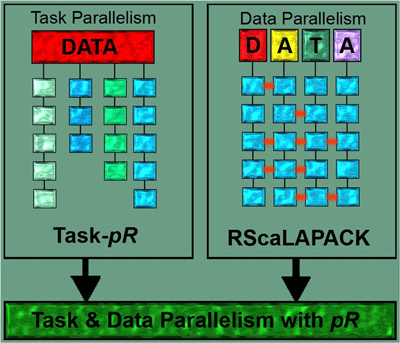Another area supported by the DMA layer is efficient statistical analysis. Present data analysis tools such as Matlab, IDL, and R, even though highly advanced in providing various statistical analysis capabilities, are not apt to handle large data-sets. Most of the researchers’ time is spent on addressing data preparation and management needs of their analyses. Parallel R6 is an open source parallel statistical analysis package developed by the SDM center that lets scientists employ a wide range of statistical analysis routines on high performance shared and distributed memory architectures without having to deal with the intricacies of parallelizing these routines. Through Parallel R, the user can distribute data and carry out the required parallel computation but maintain the same look-and-feel interface of the R system. Two major levels of parallelism are supported: data parallelism (k-means clustering, Principal Component Analysis, Hierarchical Clustering, Distance matrix, Histogram) and task parallelism (Likelihood Maximization, Bootstrap and Jackknife Re-sampling, Markov Chain Monte Carlo, Animations). Figure 6 shows a schematic of the concepts. ParallelR has been applied in multiple scientific projects including feature extraction for quantitative high-throughput proteomics, parallel analyses of climate data, and in combination with geographical information systems.

Another aspect of effective data analysis supported by the DMA technology in the SDM center, is the ability to identify, in real-time, items of interest from billions of data values in large datasets. This is a significant challenge posed by the huge amount of data being produced by many data-intensive science applications. For example, a high-energy physics experiment called STAR is producing hundreds of terabytes of data a year and has accumulated many millions of files in the last five years of operation. One of the core missions of the STAR experiment is to verify the existence of a new state of matter called the Quark Gluon Plasma (QGP). An effective strategy for this task is to find the high-energy collisions that contain signatures unique to QGP, such as a phenomenon called jet quenching. Among the hundreds of millions of collision events captured, a very small fraction of them (maybe only a few hundreds) contain clear signatures of jet quenching. Efficiently identifying these events and transferring the relevant data files to analysis programs are a great challenge. Many data-intensive science applications are facing similar challenges in searching their data.
Over the last several years, we have been working on a set of strategies to address this type of searching problem. Usually, the data to be searched are read-only. Our approach takes advantage of this fact. We have developed a specialized indexing method based on representing the indexed data as a compressed bitmap. This indexing method, called FastBit,7 is an extremely efficient bitmap indexing technology. Unlike other bitmap indexes that assume low cardinality of possible data values, FastBit is particularly useful for scientific data, since it is designed for high-cardinality numeric data. FastBit performs 12 times faster than any known compressed bitmap index in answering range queries. Because of its speed, Fastbit facilitates real-time analysis of data, searching over billions of data values in seconds. FastBit has been applied to several application domains, including finding flame fronts in combustion data, searching for rare events from billions of high energy physics collision events, and more recently to facilitate query-based visualization. The examples in Figure 7 (for astrophysics and combustion data) show the use of a tool, called DEX,8 that used Fastbit in combination with VTK to achieve a very fast selection of features from large datsets and their display in real-time.








